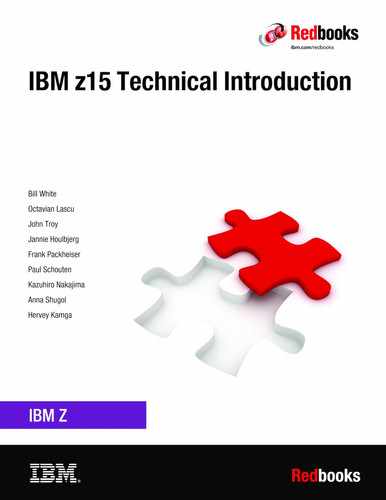This IBM® Redbooks® publication introduces the latest member of the IBM Z® platform, the IBM z15™. It includes information about the Z environment and how it helps integrate data and transactions more securely. It also provides insight for faster and more accurate business decisions. The z15 is a state-of-the-art data and transaction system that delivers advanced capabilities, which are vital to any digital transformation. The z15 is designed for enhanced modularity, and occupies an industry-standard footprint. It is offered as a single air-cooled 19-inch frame called the z15 T02, or as a multi-frame (1 to 4 19-inch frames) called the z15 T01. Both z15 models excel at the following tasks::
This book explains how this system uses innovations and traditional Z strengths to satisfy growing demand for cloud, analytics, and open source technologies. With the z15 as the base, applications can run in a trusted, reliable, and secure environment that improves operations and lessens business risk.
Table of Contents
- May 2021+Front cover
- Notices
- Preface
- Chapter 1. Designed to take on today’s IT demands
- 1.1 The IBM z15: The platform for the digital economy
- 1.1.1 Using hybrid cloud integration services
- 1.1.2 Securing and protecting data with encryption everywhere
- 1.1.3 Providing resilience: The key to zero downtime
- 1.1.4 Transforming a transactional platform into a data powerhouse
- 1.1.5 Getting more out of the platform with operational analytics
- 1.1.6 Accelerating digital transformation with agile service delivery
- 1.1.7 Revolutionizing business processes
- 1.1.8 Blending open source and IBM Z technologies
- 1.2 z15 technical description
- 1.2.1 Technical highlights
- 1.2.2 IBM z15 features and functions
- 1.2.3 Storage connectivity
- 1.2.4 Network connectivity
- 1.2.5 Cryptography
- 1.2.6 Clustering connectivity
- 1.2.7 Special-purpose features and functions
- 1.2.8 Capacity on Demand and performance
- 1.2.9 Reliability, availability, and serviceability
- 1.3 z15 software support
- 1.3.1 IBM compilers
- Chapter 2. IBM z15 Model T01 hardware overview
- Chapter 3. IBM z15 Model T02 hardware overview
- Chapter 4. Supported features and functions
- 4.1 z15 I/O connectivity overview
- 4.2 Storage connectivity
- 4.2.1 zHyperLink Express
- 4.2.2 FICON Express features
- 4.2.3 IBM Fibre Channel Endpoint Security
- 4.3 Network connectivity
- 4.4 Clustering connectivity
- 4.5 Server Time Protocol
- 4.6 Compression options
- 4.6.1 On-core Compression coprocessor
- 4.6.2 On-chip IBM Integrated Accelerator for zEnterprise Data Compression
- 4.7 Cryptographic features
- 4.7.1 Central Processor Assist for Cryptographic Functions
- 4.7.2 Crypto Express7S
- 4.7.3 Crypto Express6S and Crypto Express5S (carry forward only)
- 4.8 IBM Virtual Flash Memory
- 4.9 Hardware Management Console and Support Element
- Chapter 5. IBM z15 system design strengths
- 5.1 Technology improvements
- 5.1.1 System capacity
- 5.1.2 Processor design highlights
- 5.1.3 Memory
- 5.2 Virtualization
- 5.2.1 Hardware virtualization
- 5.2.2 Hybrid cloud environments
- 5.3 Capacity and performance
- 5.3.1 Capacity settings
- 5.3.2 Capacity on Demand
- 5.3.3 z15 performance
- 5.4 Reliability, availability, and serviceability
- 5.4.1 RAS capability for the Support Element
- 5.4.2 RAS capability for the Hardware Management Console
- 5.5 High availability with Parallel Sysplex
- 5.6 Pervasive encryption
- 5.6.1 IBM Fibre Channel Endpoint Security
- 5.6.2 IBM Data Privacy Passports
- 5.6.3 Secure Service Container
- Chapter 6. Operating system support
- 6.1 Software support summary
- 6.1.1 Operating system summary
- 6.1.2 Application development and languages
- 6.1.3 IBM compilers
- 6.2 Support by operating system
- 6.2.1 z/OS
- 6.2.2 z/VM
- 6.2.3 z/VSE
- 6.2.4 z/TPF
- 6.2.5 Linux on IBM Z
- 6.2.6 Kernel-based virtual machine hypervisor
- 6.3 Software licensing
- 6.4 References
- Back cover
